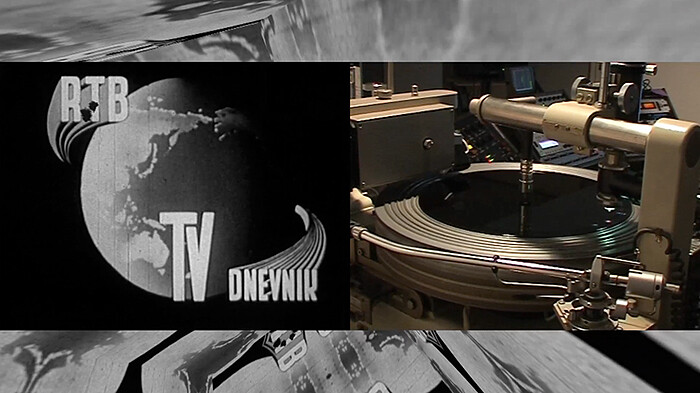Aleksandra Domanović’s practice analyzes socio-political transformations through the production of images and narratives largely based on popular culture. By decontextualizing and reconfiguring media content, Domanović delves into the accumulative nature of information and its intrinsic indexicality. Like many artists born on the communist side of the Iron Curtain, she is interested in the difficult transition towards capitalism and the emergence of new social values, and, in specific, in the case of former Yugoslavia (where she was born), how this is all exacerbated by the outbreak of an ethnic and nationalist war.
At Proyectos Monclova, Domanović presents 19:30 (2010–11), a two-channel video projection which articulates two heterogeneous sets of imagery: the opening titles of several regional news networks of the former Yugoslavia and a stream of shots of techno raves, which emerged in the same region, like in many other places in the 1990s, as a strong part of youth culture. This unlikely marriage of references is materially and conceptually made possible through the soundtrack, a remix of the news jingles made by techno DJs. While the series of opening titles evoke the socialist era of information distribution, the raves manifest forms of collective social venting in this “new” society.
Watching the work, one becomes aware of the sense of expectancy which has been increasingly built into news broadcast visual language everywhere. The daily news here—of which Domanović never shows us specific content—represents the rising tension which led to war, while the techno culture (which arose after the signature of the Dayton Accords in 1995) comes to stand in for a non-nationalistic, free-spirited attitude towards a yet uncertain future.
Unlike other of her works, 19:30 refuses to communicate with language, the contradictory environment of progressively glossy television design and frantic dancing is missing here that one finds, for instance, in her video essay Turbo Sculpture (2010) which traces the influence of Western culture by describing the appearance of statues of Hollywood celebrities in many cities of the former Yugoslavia as an attempt to represent ethnic cohesion in an otherwise deeply divided society.
For her part, Sharon Hayes presents I March in the Parade of Liberty, but as Long as I Love You I’m Not Free (2007–8), a piece composed of a sound recording and a spray-paint drawing on paper. The sound records an action in which Hayes addresses her unnamed lover through a megaphone in the streets of New York during five non-consecutive days between December and January 2007–8. Similar to other recent pieces, Hayes connects politics to desire or, rather, she articulates a politics of desire. Through a long exploration of the act of public speech and the spaces of political self-representation, Hayes has increasingly involved sexuality and intimacy in the configuration of political discourse, unveiling the impetuous force of affection in the construction of a political self.
In I March in the Parade of Liberty, but as Long as I Love You I’m Not Free, the artist partly describes a situation in which political engagement against the war both unites and separates two lovers. Beautifully corny at times, Hayes’s speech is as idealistic—“There is no prison in any world into which love cannot force an entrance”—as nostalgic about past common struggles—“…the ecstasy of being gay and angry.” Hayes speaks publicly about abandonment and despair in relation to both political representation and a love affair, using the formal language of a demonstration, and thus revealing a thin, porous boundary between a private (in this case impossible) communication and public speech in which communication is not necessarily implied.
The drawing functions perhaps as a caption (as it features the title of the work and the dates the action originally took place), stenciled on paper with spray paint. This helpless call for action in such a personal affair prompts again the intrinsic relation between love and politics.
However gratuitous the combination of Domanović’s and Hayes’s works under such a small roof may seem (the gallery collaborated with Tanya Leighton who represents both artists) together they convey a certain tension between the very personal and the necessarily collective, the amplified individual voice and the wordless shared experience of transient liberation.





